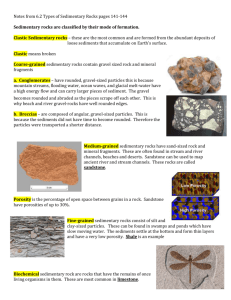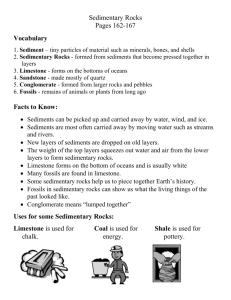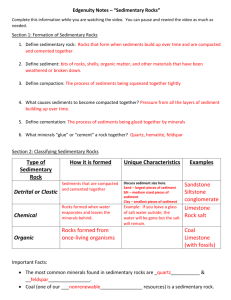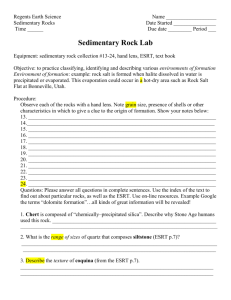3.3 Sedimentary Rocks Reading and Qs
advertisement
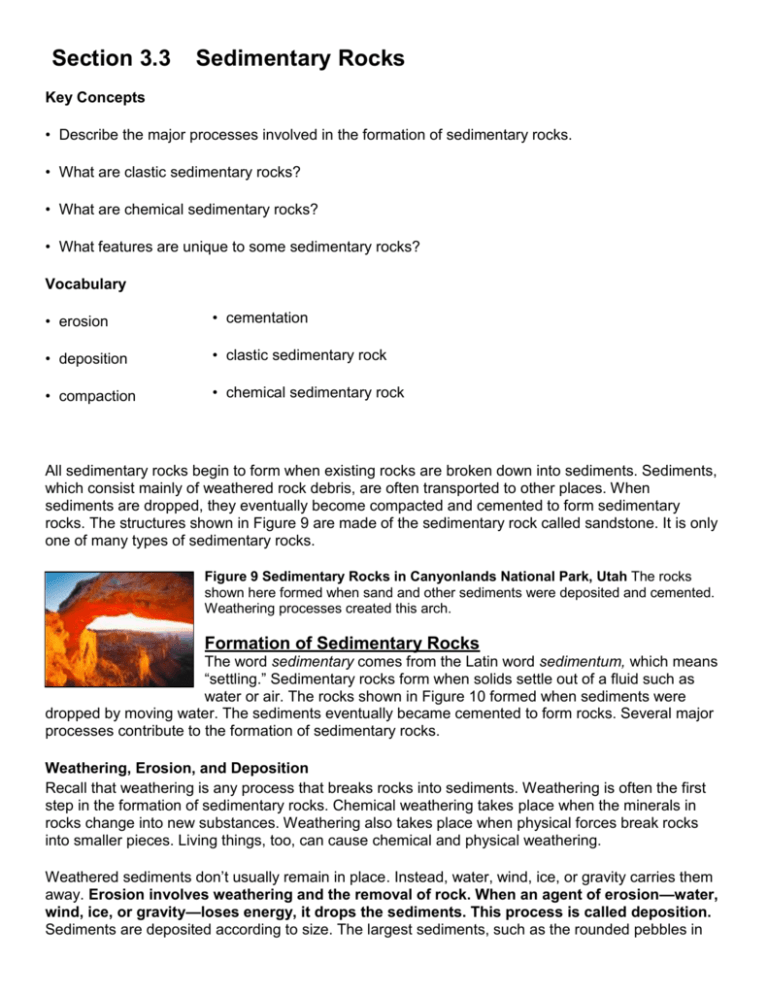
Section 3.3 Sedimentary Rocks Key Concepts • Describe the major processes involved in the formation of sedimentary rocks. • What are clastic sedimentary rocks? • What are chemical sedimentary rocks? • What features are unique to some sedimentary rocks? Vocabulary • erosion • cementation • deposition • clastic sedimentary rock • compaction • chemical sedimentary rock All sedimentary rocks begin to form when existing rocks are broken down into sediments. Sediments, which consist mainly of weathered rock debris, are often transported to other places. When sediments are dropped, they eventually become compacted and cemented to form sedimentary rocks. The structures shown in Figure 9 are made of the sedimentary rock called sandstone. It is only one of many types of sedimentary rocks. Figure 9 Sedimentary Rocks in Canyonlands National Park, Utah The rocks shown here formed when sand and other sediments were deposited and cemented. Weathering processes created this arch. Formation of Sedimentary Rocks The word sedimentary comes from the Latin word sedimentum, which means “settling.” Sedimentary rocks form when solids settle out of a fluid such as water or air. The rocks shown in Figure 10 formed when sediments were dropped by moving water. The sediments eventually became cemented to form rocks. Several major processes contribute to the formation of sedimentary rocks. Weathering, Erosion, and Deposition Recall that weathering is any process that breaks rocks into sediments. Weathering is often the first step in the formation of sedimentary rocks. Chemical weathering takes place when the minerals in rocks change into new substances. Weathering also takes place when physical forces break rocks into smaller pieces. Living things, too, can cause chemical and physical weathering. Weathered sediments don’t usually remain in place. Instead, water, wind, ice, or gravity carries them away. Erosion involves weathering and the removal of rock. When an agent of erosion—water, wind, ice, or gravity—loses energy, it drops the sediments. This process is called deposition. Sediments are deposited according to size. The largest sediments, such as the rounded pebbles in the conglomerate in Figure 10A, are deposited first. Smaller sediments, like the pieces of sand that make up the sandstone in Figure 10B, are dropped later. Some sediments are so small that they are carried great distances before being deposited. A Figure 10 Although these two rocks appear quite different, both formed when sediments were dropped by moving water. A Conglomerate is made of rounded pebbles cemented together. B Sandstone is made of sand grains cemented together. B Compaction and Cementation After sediments are deposited, they often become lithified, or turned to rock. Compaction and cementation change sediments into sedimentary rock. Compaction is a process that squeezes, or compacts, sediments. Compaction is caused by the weight of sediments. During compaction, much of the water in the sediments is driven out. Cementation takes place when dissolved minerals are deposited in the tiny spaces among the sediments. Much of the cement in the conglomerate shown in Figure 10A can be seen with the unaided eye. The cement holding the sand grains together in the sandstone in Figure 10B, however, is microscopic. (a)Briefly describe the five major processes involved in the formation of sedimentary rocks. Classification of Sedimentary Rocks Just like igneous rocks, sedimentary rocks can be classified into two main groups according to the way they form. The first group includes rocks that are made of weathered bits of rocks and minerals. These rocks are called clastic sedimentary rocks. The second group forms when dissolved minerals precipitate from water solutions. These rocks are called chemical sedimentary rocks. Clastic Sedimentary Rocks Many different minerals are found in clastic rocks. The most common are the clay minerals and quartz. This is because clay minerals, like those that make up much of the shale in Figure 11A, are the most abundant products of chemical weathering. Quartz, which is a major mineral in the breccia shown in Figure 11B, is a common sedimentary mineral for a different reason. It is very durable and resistant to chemical weathering. A Figure 11 A Shale and B breccia are common clastic sedimentary rocks. This sample of shale contains plant fossils. Formulating Hypotheses How do you think this breccia might have formed? B Clastic sedimentary rocks can be grouped according to the size of the sediments in the rocks. When rounded, gravel-size or larger particles make up most of the rock, the rock is called conglomerate. If the particles are angular, the rock is called breccia. Sandstone is the name given to rocks when most of the sediments are sand-size grains. Shale, the most common sedimentary rock, is made of very fine-grained sediment. Siltstone is another fine-grained rock. (a)Describe the major types of clastic sedimentary rocks. Chemical and Biochemical Sedimentary Rocks Chemical sedimentary rocks form when dissolved substances precipitate, or separate, from water solution. This precipitation generally occurs when the water evaporates or boils off leaving a solid product. Examples of this type of chemical rock are some limestones, rock salt, chert, flint, and rock gypsum. About 90 percent of limestones are formed from biochemical sediments. Such sediments are the shells and skeletal remains of organisms that settle to the ocean floor. The coquina in Figure 12 is one obvious example. You can actually see the shells cemented together. Another biochemical rock is chalk, the material used to write on a chalkboard. Figure 12 This biochemical rock, called coquina, is a type of limestone that is made of hundreds of shell fragments. Features of Some Sedimentary Rocks Sedimentary rocks, like other types of rocks, are used to unravel what may have happened in Earth’s long history. The many unique features of sedimentary rocks are clues to how, when, and where the rocks formed. Each layer of a sedimentary rock, for example, records a period of sediment deposition. In undisturbed rocks, the oldest layers are found at the bottom. The youngest layers are found at the top of the rocks. Ripple marks like the ones shown in Figure 13A may indicate that the rock formed along a beach or stream bed. The mud cracks in Figure 13B formed when wet mud or clay dried and shrank, leaving a rock record of a dry environment. A Figure 13 A Ripple marks and B mud cracks are features of sedimentary rocks that can be used to learn about the environments in which the rocks formed. B Fossils, which are the traces or remains of ancient life, are unique to some sedimentary rocks. Fossils can be used to help answer many questions about the rocks that contain them. For example, did the rock form on land or in the ocean? Was the climate hot or cold, rainy or dry? Did the rock form hundreds, thousands, millions, or billions of years ago? Fossils also play a key role in matching up rocks from different places that are the same age. To summarize, sedimentary rocks are rocks that form as the result of four major processes. Weathering produces particles called sediments. Wind, water, ice, and gravity erode and deposit these sediments. Over time, the sediments are compacted and cemented to form rocks. Sedimentary rocks can be classified according to how they form. A general classification scheme based on a rock’s formation, texture, and composition is shown in Table 2. SECTION 3.3 Assessment Reviewing Concepts (1)Contrast weathering, erosion, and deposition. (2)Name four clastic sedimentary rocks and explain how these rocks form. (3)Name four chemical sedimentary rocks and explain how these rocks form. (4)Explain how three different features of sedimentary rocks can be used to determine how, where, or when the rocks formed. (5)What is compaction? (6)Where do the cements that hold sediments together come from? Critical Thinking (7) Applying Concepts Briefly describe how the rock shown in Figure 12 may have formed. (8) Predicting Which type of sediments do you think would undergo more compaction—grains of sand or grains of clay? Explain your choice.


